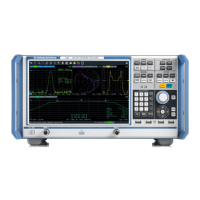Concepts and Features
R&S
®
ZNB/ZNBT
134User Manual 1173.9163.02 ─ 53
f = frequency in Hz
In practice, the analyzer calculates an approximation to the derivative of the phase
response, taking a small frequency interval Δf and determining the corresponding
phase change ΔΦ. The delay is thus computed as:
f
deg
measg
360
,
The aperture Δf must be adjusted to the conditions of the measurement.
If the delay is constant over the considered frequency range (non-dispersive DUT, e.g.
a cable), then τ
g
and τ
g,meas
are identical and:
c
L
t
fd
tfd
mech
g
360
)360(
where Δt is the propagation time of the wave across the DUT, which often can be
expressed in terms of its mechanical length L
mech
, the permittivity ε, and the velocity of
light c. The product L
mech
· sqrt(ε) is termed the electrical length of the DUT and is
always larger or equal than the mechanical length (ε > 1 for all dielectrics and ε = 1 for
the vacuum).
5.4 Operations on Traces
The R&S ZNB/ZNBT can perform more complex operations on the measured traces.
Some of the operations, e.g. the time domain transform, require additional software
options; see Chapter 5.7, "Optional Extensions and Accessories", on page 202.
The R&S ZNB/ZNBT can also check whether the measured values comply with speci-
fied limits and export trace data, using different file formats.
5.4.1 Limit Check
A limit line restricts the allowed range for some or all points of a trace, i.e. for a certain
range of stimulus values. Typically, limit lines are used to check whether a DUT con-
forms to the rated specifications (conformance testing).
●
An upper limit line defines the maximum allowed values for the related stimulus
range.
●
A lower limit line defines the minimum allowed values for the related stimulus
range.
●
A ripple limit defines the maximum difference between the largest and the smallest
response value for the related stimulus range. A ripple limit test is suitable, e.g., to
check whether the passband ripple of a filter is within acceptable limits, irrespective
of the actual transmitted power in the passband.
●
A circle limit defines the acceptable values as a circular area within a complex dia-
gram.
Operations on Traces

